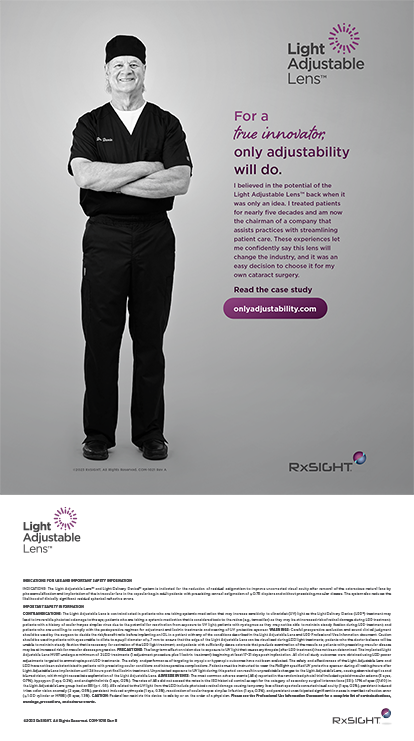
Comparison of Sutured Versus Sutureless Scleral-Fixated Intraocular Lenses
Sindal MD, Nakhwa CP, Sengupta S1
ABSTRACT
In a retrospective study performed at a tertiary referral eye care center in South India, Sindal and colleagues compared the intermediate-term anatomic and visual results of sclera-fixated IOLs using four-point suture fixation or transscleral sutureless fixation. The study included consecutive patients from 2010 to 2014 with more than 1 year of follow-up. The indication for sclera-fixated IOL implantation was aphakia as a complication of cataract surgery or posttraumatic aphakia. The decision of technique was based solely on the surgeon’s preference. Eyes that had any additional procedures such as retinal detachment repair or vitrectomy for endophthalmitis were excluded.
AT A GLANCE
• A retrospective study of 109 cases compared the intermediate-term anatomic and visual results of sclera-fixated IOLs using four-point suture fixation or transscleral sutureless fixation. The researchers concluded that the two approaches had equally good success rates and similar complication rates.
• A retrospective study of 584 men (864 eyes) found that patients on tamsulosin had an increased risk of an IOP spike 1 day after cataract surgery.
In the sutured sclera-fixated IOL group, a rigid PMMA lens was secured with a 10–0 polypropylene suture. Anesthesia was administered via a peribulbar injection. The sutureless sclera-fixated technique involved the creation of scleral tunnels and placement of a three-piece rigid IOL with a PMMA optic and polypropylene haptics. Both groups used a topical antibiotic-steroid combination for 6 weeks (Figure 1).
The investigators analyzed 109 cases. The mean follow-up period was 18.9 months. Eighty-six percent of eyes had a Snellen equivalent corrected distance visual acuity of 6/12 or better. Baseline characteristics and final visual outcomes were similar between the groups. The researchers concluded that sutured and sutureless sclera-fixated IOLs have equally good success rates and that the complication rates of the two surgeries are similar.
Figure 1. Both haptics externalized on a sutureless IOL.
Figure 2. A new approach to four-point fixation of IOLs with Gore-Tex sutures.
DISCUSSION
This study supports what many surgeons already believe: both types of scleral fixation work and yield good visual results. Is scleral fixation of a lens always imperative? In a review involving more than 180 eyes, Donaldson and colleagues found no significant difference in outcome between anterior chamber IOLs and sutured posterior chamber IOLs after complicated cataract extraction in the presence of poor capsular support.2
The study by Sindal and colleagues used a 10–0 Prolene suture (Ethicon). Price and colleagues reported using 9–0 sutures instead for their higher tensile strength.3 Recently, many surgeons have advocated using polytetrafluoroethylene (Gore-Tex; W.L. Gore & Associates) for IOL fixation.4 This suture will not degrade over time, but its use in ophthalmology is not FDA approved, which must be disclosed during informed consent. Another point regarding the study by Sindal and colleagues is that no glue was used for the sutureless group. Agarwal and colleagues have described a technique that employs fibrin glue to help secure the IOL’s haptic and flap into the sclera.5
There are numerous approaches to these cases, but limited data mean one technique has yet to be proven superior to another (Figure 2; see Watch It Now). This study adds to the evidence supporting two approaches to fixating IOLs. The deciding factors are the individual surgeon’s preference and comfort level.
One-Day Postoperative Intraocular Pressure Spikes After Phacoemulsification Cataract Surgery in Patients Taking Tamsulosin
Bonnell LN, SooHoo JR, Seibold LK, et al6
ABSTRACT
Bonnell and colleagues performed a retrospective study to evaluate the relationship between IOP spikes 1 day after phaco cataract surgery and tamsulosin use. The investigators used the University of Colorado Health Eye Center’s Cataract Outcomes Registry to identify patients for inclusion in the study. The primary exclusion criteria were women, patients who had cataract surgery combined with another surgery, patients younger than 18 years of age, patients with traumatic cataracts, and patients whose IOP was not measured 1 day postoperatively. The study included 584 men (864 eyes), some of whom were taking tamsulosin at the time of surgery, and utilized patients without a history of tamsulosin as controls. Primary outcomes were defined as a 1-day postoperative IOP spike that was greater than 10 mm Hg compared with baseline or that was 30 mm Hg or higher.
The investigators concluded that patients on tamsulosin had an increased risk of an IOP spike 1 day after cataract surgery. An increase in IOP of more than 10 mm Hg or an IOP of 30 mm Hg or higher after cataract surgery occurred in 12.4% and 9.3% of tamsulosin patients, respectively, versus 4.4% and 2.1%, respectively, in the control group. After the researchers adjusted for covariates (such as age and the use of Malyugin Rings [MicroSurgical Technology]), patients on tamsulosin were 2.6 times more likely to experience a postoperative IOP spike greater than 10 mm Hg and 3.8 times more likely to have an IOP spike of 30 mm Hg or higher.
Michael Patterson, DO, performs four-point suture fixation of a lens implant after an IOL exchange.
Dr. Patterson performs sutureless intrascleral fixation of an IOL and anterior vitrectomy in a child.
DISCUSSION
In 2005, Chang and Campbell first reported the condition they dubbed intraoperative floppy iris syndrome.7 Since then, the number of US patients on tamsulosin seems to have grown. The study by Bonnell and colleagues therefore has profound implications, should future research validate these data. No other study of which this author is aware has specifically examined the relationship between tamsulosin and IOP spikes after cataract surgery. The finding of Bonnell and colleagues suggests that patients using tamsulosin may require close monitoring, at least during the perioperative period. Should their IOP be checked on the same day as their cataract surgery? This strategy could be especially beneficial to patients with glaucoma who have a propensity for an IOP spike. Will cataract surgeons one day need to treat intraoperative floppy iris syndrome patients prophylactically with ocular hypotensive therapies? Regardless, this study re-emphasizes the importance of identifying tamsulosin patients prior to cataract surgery and closely monitoring them postoperatively.
1. Sindal MD, Nakhwa CP, Sengupta S. Comparison of sutured versus sutureless scleral-fixated intraocular lenses. J Cataract Refract Surg. 2016;42(1):27-34.
2. Donaldson KE, Gorsack JJ, Budenz DL, et al. Anterior chamber and sutured posterior chamber intraocular lenses in eyes with poor capsular support. J Cataract Refract Surg. 2005;31(5):903-909.
3. Price MO, Price FW Jr, Werner L, et al. Late dislocation of scleral-sutured posterior chamber intraocular lenses. J Cataract Refract Surg. 2005;31(7):1320-1326.
4. Snyder ME, Perez MA. Tiltless and centration adjustable scleral-sutured posterior chamber intraocular lens. J Cataract Refract Surg. 2014;40(10):1579-1583.
5. Agarwal A, Kumar DA, Jacob S, et al. Fibrin glue-assisted sutureless posterior chamber intraocular lens implantation in eyes with deficient posterior capsules. J Cataract Refract Surg. 2008;34(9):1433-1438.
6. Bonnell LN, SooHoo JR, Seibold LK, et al. One-day postoperative intraocular pressure spikes after phacoemulsification cataract surgery in patients taking tamsulosin. J Cataract Refract Surg. 2016;42(12):1753-1758.
7. Chang DF, Campbell JR. Intraoperative floppy iris syndrome associated with tamsulosin. J Cataract Refract Surg. 2005;31(4):664-673.




